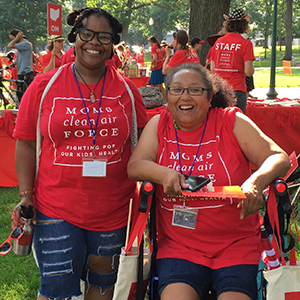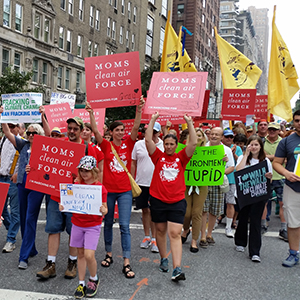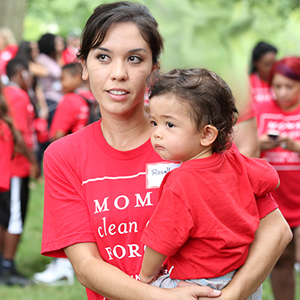
For 26 years, the American Lung Association has released a “State of the Air” report, which is widely considered our country’s annual air quality report card. It’s full of data and typically concludes with robust recommendations for action, like supporting federal clean air protections that must be finalized. This year, for the first time in the history of the report, there’s only one listed recommendation: Save EPA.
Tell Congress: Defend EPA’s Ability to Protect Human Health and the Environment
This single clarion call to action underscores the urgency of the fight for clean air under Trump’s second term. EPA Administrator Lee Zeldin’s plans to gut the agency and roll back protections are at stark odds with its mission to protect public health and the environment.
“We are calling on Congress to protect staff, mission, and programs at EPA,” explains Laura Kate Bender, Assistant Vice President, Nationwide Healthy Air, at the American Lung Association. Among the many things currently at risk is the data needed for the “State of the Air” reports if there isn’t funding for federal air monitoring or EPA staff doing the day-to-day work of crunching numbers.
“We want to help people understand the value of EPA’s staff and programs and the critical work being done across the country to help protect people’s lungs. We need strong protections and people to implement and enforce them. None of that happens without a strong EPA.”
The 2025 overview
Laura Kate says the 2025 report doesn’t contain great news. “We are up to nearly half the country living in places with unhealthy air pollution—a lot worse than last year,” she notes.
According to the report, even after decades of successful efforts to reduce sources of air pollution, 46% of people in the U.S.—that’s a whopping 156.1 million—are living in places that get failing grades for unhealthy levels of ozone or particle pollution. This is nearly 25 million more people breathing unhealthy air compared to last year’s report, and more than in any other “State of the Air” report in the last 10 years.
Notably, the 2025 report covers data from 2021 to 2023, and its results reflect wildfire smoke that blew over much of the U.S. from Canada during that time.
Five takeaways from the report
1. Global-warming-fueled extreme weather is harming clean air gains. For decades, Laura Kate notes, we have been seeing better air quality as Clean Air Act protections came into place. “But in the past couple of years, we’ve seen an uptick, and we can tie a lot of it to climate impacts. Extreme heat, drought, and wildfires contribute to worsening levels of air pollution across much of the U.S., exposing a growing proportion of the population to ozone and particle pollution that put their health at risk.” Increases in high ozone days and spikes in particle pollution related to extreme weather also add challenges to the work being done nationwide to clean up air pollution.
2. The burden of living with unhealthy air is not shared equally. Communities of color are disproportionately exposed to unhealthy air and are also more likely to be living with one or more chronic conditions, like asthma, diabetes, and heart disease, that make them more vulnerable to pollution. While people of color make up 41.2% of the overall population of the U.S., they are 50.2% of people living in a county with at least one failing grade for air quality. And there are further disparities within communities of color too. From the report, “Notably, Hispanic individuals are nearly three times as likely as white individuals to live in a community with three failing grades.”
3. Ozone pollution is getting worse. Ninety-three more counties earned an F grade in 2025 than in 2024’s report. Also, 10 more states saw at least one of their counties added to the list. Many places that were considered “untroubled” by ozone, a.k.a. smog, in recent reports saw their air quality worsen in 2025’s report, sometimes by a lot—137 counties lost their A grade, including 10 that went from an A to an F. Laura Kate calls 2025’s ozone numbers “interesting” and says extreme heat as well as wildfire smoke were to blame. Wildfire smoke is often discussed as a particle pollution concern, but chemical reactions that occur when smoke particles and gases interact with sunlight can create ozone.
4. Particle pollution is also getting worse. In the years analyzed in the 2025 report—2021, 2022, and 2023—there were 77.2 million people living in counties across the U.S. that earned an F grade for unhealthy spikes in particle pollution, a.k.a. soot. This is an increase of 12.1 million more people than in 2024’s report, the seventh straight year of increasing health threat from particle pollution.
5. Children and older adults are most at risk. More than 34.6 million children under age 18 and 25.2 million adults age 65 and over live in the counties that received an F for at least one pollutant. Close to 9.5 million children and more than 6.7 million seniors live in counties failing all three measures.
What’s in store for 2026?
We know from consecutive American Lung Association reports that air pollution is getting worse. And a recent study from researchers at Johns Hopkins says the health impacts of air pollution are likely being underestimated by traditional risk models. This study also offers a new way to measure cumulative risk. Now that we have an EPA more focused on aiding polluters than people, it’s difficult to imagine what future reports will look like.
While no one can predict the future, we can all take action. Laura Kate suggests people interested in air quality and safety get involved locally. “There are states doing cool things above and beyond EPA regulatory monitors. Oregon even has a network of state and local monitoring projects. There is a lot of good work out there,” she says.
Still, EPA funding is critical for state air agencies too, so we would all do well to heed the American Lung Association’s 2025 call to action and demand Congress save EPA.
Tell Congress: Defend EPA’s Ability to Protect Human Health and the Environment




